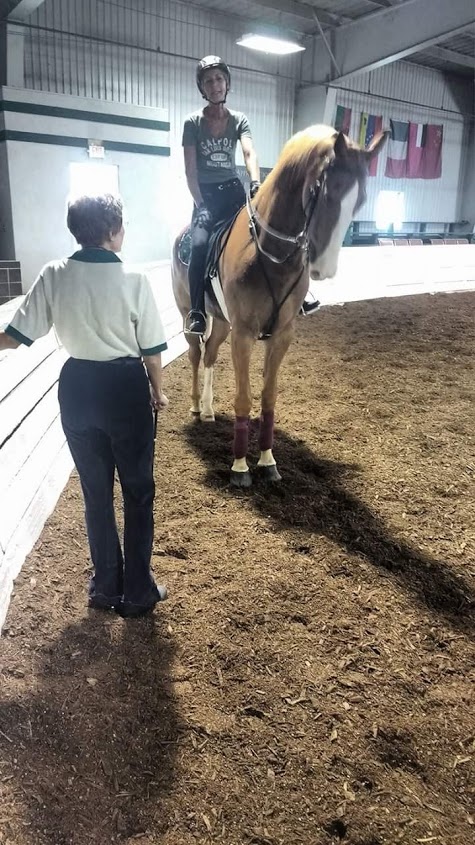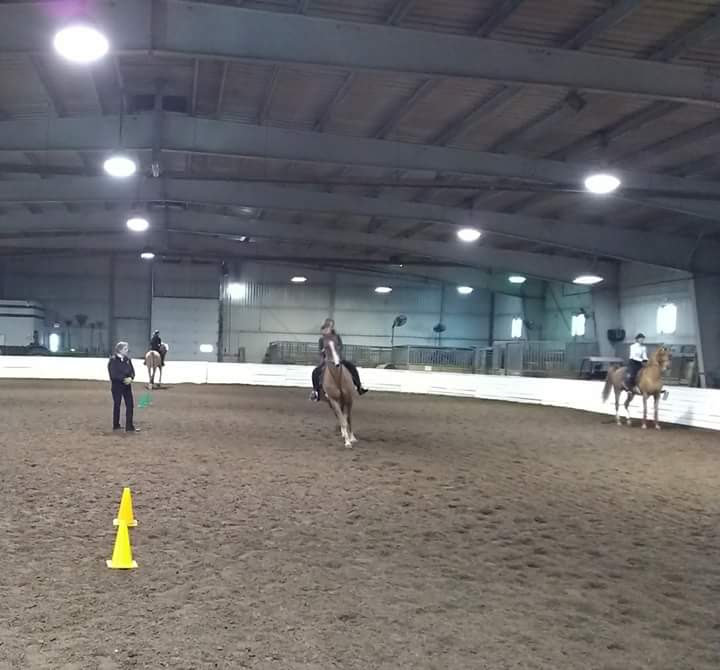I recently had the privilege of attending Ms. Gayle Lampe's saddle seat riding clinic. Though I grew up riding saddle seat, in my recent adult life most of my riding has been dressage or western, specifically vaquero, and it’s been shamefully long since I’ve had any exposure to the saddle seat world.

So, with hopes of blowing the dust off my saddle seat knowledge, and greasing some rusty gears like the slow-gait and rack, I set out to further my understanding of this discipline by attending my first ever saddle seat clinic.
To put into words the amount of knowledge one can glean from spending days with Ms. Lampe seems like a formidable task at best. There is so very much to be learned when in the presence of such a master! Would that I could learn by osmosis, but alas, my humanity has confined me to processing bits and pieces of such nuggets of information. Much of what Ms. Lampe teaches is less about equitation and more about horsemanship (to my unequitated body's relief), which seems a subject all of us would do well to become lifelong students of.
These are the top gems I walked away with after four days spent with the legend:
Slide your saddle.
Don’t bounce up and down on your horse’s back, especially at the canter. Sit deep and slide your saddle. Rock it like a swing, but kindly make sure you aren’t bouncing over your horse’s kidneys as is sadly commonly seen. Sit. Slide. Ride on!
Always bump UP with your hands.
This was one I really struggled with after so much hackamore time. Bump UP in the bridle, not straight back and not to your hips, but up; straight UP.
Don't get your reins in a vise.
In keeping with your hands, which should be bumping UP now, make sure you don’t get your horse in a vise with the reins. Give and take. Bump and release. Call it whatever you want to call it, but don’t hold steadily. Your hands are not a vise. Make your correction and then turn loose of the reins.
Don’t let the rail guide your horse.
While your hands are not a vise, they ARE for communication. Use them (and use the rest of your body) to guide your horse. Don’t let the rail steer your horse, especially when working figures in the middle of the arena and returning to the rail. You should guide your horse at all times, NOT the rail.
Organize your ride.
Pay attention to detail and make a pretty package. Keep the bight of your reins on the off side, have your underpasses down, bridle straps tucked into keepers, and your stirrup leather tails behind your leg. Have your reins at an appropriate length, look up, bridle your horse, sit squarely, and organize your ride. Don’t let your horse be strung out. Don’t flop around like a sack of potatoes. Be organized in appearance and demeanor.

Do your work in the corners.
Work in the corners and let the straightaway be your stage. Bridle your horse in the corners. Check his mouth. Slow him down and tuck him back in to keep him collected. Do your work in the corners. Then, when you come down the straightaway, you’ll have everything ready to go and will be able to really strut your stuff.
Always think ahead.
At the beginning of the straightaway, figure out how to keep out of trouble at the end of it. As you come out of the corner (aka “your workshop”), look up and determine where it’s best for you to be, then get there. Plan ahead for the pack of horses in front of you. After you’ve gotten your horse ready in the corner, you need to keep out of trouble to showcase your talent.
Never say “Whoa,” to a fast traveling gaited horse...
...unless you want him to stop, of course. If a horse is getting too quick in the slow-gait and you say “Whoa,” they will reach for the trot and ultimately the walk.
When your happy-to-gait horse won’t trot, stop, back him up, and then send him forward.
This trick seemed absolutely genius to me, and I later got to see it implemented – successfully. Because a horse backs in diagonal pairs, his feet will be arranged to trot, rather than slow-gait, after backing. It’s a gemstone of information that makes perfect sense, but who knew?!
Sadly, my time with Ms. Lampe had to come to a close, but I’ll be ever grateful for the hours I spent with her, particularly those which were joined by a horse. Once I got home, I changed a few things in my western and dressage riding, like bumping UP, and found I had a much better ride. If ever fate grants you the opportunity to attend one of Ms. Lampe’s clinics, I definitely advise you to do so. I can guarantee you won’t regret it and that, no matter your current discipline(s), you’ll walk away with a wealth of information to help you in your journey.



